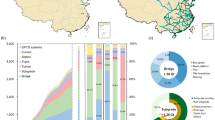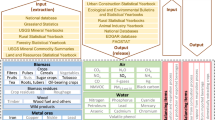Abstract
Materials stocked in infrastructure provide necessary personal and economic services, and are also closely linked with massive resource extraction, energy consumption and waste generation. To support policy deliberations toward regional harmony and sustainable development, this paper examines the temporal change during 1978–2008 and spatial patterns of ten types of materials stocked in four major infrastructures (residential buildings, roads, railways, and water pipelines) in 31 provinces in China, and diagnoses regional disparity and driving factors by Theil index and multivariable regression based on panel data. It was found that the total material stock has boomed to 42.5 billion tons in 2008, with its per capita level increased by nine times over that in 1978. Over 90 % of materials are concentrated in residential buildings and roads, and are spatially inclined to decrease from coastal regions to inland areas. Since China has shifted its strategy from an inclined to harmonious regional development, the overall inequality of per capita material stock has been changing toward equality with its scale contributed mainly by inter-regional inequality, and downward trend affected dominantly by intra-regional inequality. To balance the growth speed across regions meanwhile, to develop economy and attract foreign investment in each region, would be a promising route towards reducing regional inequality. Moreover, the enhancement of governmental performance and construction of each sector’s share would also be effective for decreasing inter-regional gaps.





Similar content being viewed by others
References
Akita T (2003) Decomposing regional income inequality in China and Indonesia using two-stage nested Theil decomposition method. Ann Reg Sci 37:55–77
Beers DV, Graedel TE (2004) The magnitude and spatial distribution of in-use Zinc stocks in Cape Town, South Africa. Afr J Environ Assess Manag 9(1):18–36
Bringezu S, Schutz H, Steger S, Baudisch J (2004) International comparison of resource use and its relation to economic growth, the development of total material requirement, direct material inputs and hidden flows and the structure of TMR. Ecol Econ 51:97–124
Burgess EW (1925) The trend of population, vol XVIII. Publications of the American Sociological Society by the University of Chicago Press, pp 85–97
Center for Housing Industrialization (2011) China’s effort for the promotion of housing industrialization. http://www.chinahouse.gov.cn. Accessed 2 May 2011 (in Chinese)
Chen X, Nordhaus WD (2011) Using luminosity data as a proxy for economic statistics. Proc Natl Acad Sci USA 108(21):8589–8594
Daigo I, Hashimoto S, Matsuno Y, Adachi Y (2009) Material stocks and flows accounting for copper and copper-based alloys in Japan. Resour Conserv Recycl 53:208–217
DRCSCC (2005) Forecast report of the steel consumption of China 2005–2010. Beijing, China (in Chinese)
DRCSCC (Development Research Center of State Council of China) (2005a) Strategies and policies for regional harmonious development. http://www.drc.gov.cn/view.asp?doc_ID=030955. Accessed 10 June 2009 (in Chinese)
DURCEP (Department of Urban and Rural Construction and Environmental Protection) (1986) The first urban housing survey report. China Statistics Press, Beijing
Eberts RW (1990) Public infrastructure and regional economic development. Econ Rev 26(1):15–27
Fujita M, Hu D (2001) Regional disparity in China 1985–1994: the effects of globalization and economic liberalization. Ann Reg Sci 35:3–37
Hashimoto S, Tanikawa H, Moriguchi Y (2009) Framework for estimating potential wastes and secondary resources accumulated within an economy-a case study of construction minerals in Japan. Waste Manage (Oxford) 29:2859–2866
Hu MM, Pauliuk S, Wang T, Hupper G, Voet E, Muller DB (2010a) Iron and steel in Chinese residential buildings: a dynamic analysis. Resour Conserv Recycl 54:591–600
Hu D, You F, Zhao Y, Yuan Y, Liu T, Cao A, Wang Z, Zhang J (2010 b) Input, stocks and output flows of urban residential building system in Beijing city, China from 1949 to 2008. Resour Conserv Recycl 54:1177–1188
Huang T, Shi F, Fei JL, Tanikawa H, Imura H (2010) Study on the material stock of transportation construction associated with the development of infrastructure in China. Environ Inf Sci 24:149–154
IIASA (International Institute for Applied Systems Analysis) (2002) Material flows and economic development-material flow analysis of the hungarian economy. Interim Report No. 02-057, Laxenburg
Jeffrey MW (2002) Econometric analysis of cross section and panel data. MIT Press, London
Kennedy C, Cuddihy J, Yan JE (2007) The changing metabolism of cities. J Ind Ecol 11(2):43–59
Leigh NG, Realff MJ, Ai N, French SP, Ross Cl, Bras B (2007) Modeling obsolete computer stock under regional data constraints: an Atlanta case study. Resour Conserv Recycl 51:847–869
Liu TX, Hu D (2006) Environmental impact of residential building construction in Beijing: 1949–2003. Assessing the construction materials’ environmental impact by LCA (in Chinese with English abstract). J Grad Sch Chin Acad Sci 23(2):231–241
MOHURD (Ministry of Housing and Urban-Rural Development of China) (2009) China urban construction statistical yearbook. China Planning Press, Beijing
MTC (1999) Design specifications for railway line GB 50090–1999 (in Chinese). China Ministry of Transportation Press, Beijing
MTC (2000–2009) Yearbook of China transportation & communications. Yearbook house of China Transportation & Communications Press, Beijing
MTC (2006) Design specifications for railway line GB 50090–2006 (in Chinese). China Ministry of Transportation, Beijing
MTC (2007) Financial estimates for road project JTG/T B06–01-2007 (in Chinese). China Ministry of Transportation, Beijing
MTC (2010) Code for design of outdoor wastewater engineering (in Chinese). China Planning Press, Beijing
MTC (Ministry of Transportation of China) (1986) Design Specifications for Railway Line GBJ 90–85 (in Chinese). China Ministry of Transportation, Beijing
Muller DB (2006) Stock dynamics for forecasting material flows-case study for housing in The Netherlands. Ecol Econ 59:142–156
NBS (2009) China rural statistical yearbook. China Statistics Press, Beijing
NBS (2010) Comprehensive statistical data and materials on 60 years of new China. China Statistics Press, Beijing
NBS (National Bureau of Statistics) (1996–2009) China statistical yearbook. China Statistics Press, Beijing
NDRCC (National Development and Reform Commission of China) (2004) Mid- and long-term rail network planning (in Chinese). http://jtyss.ndrc.gov.cn. Accessed 28 May 2011
OECD (2001) Measuring capital OECD manual. Measurement of capital stocks, consumption of fixed capital and capital services. OECD, Paris. http://www.oecd.org. Accessed 22 November 2010
Oxford Dictionaries (2011) http://www.oxforddictionaries.com/definition/infrastructure. Accessed 12 May 2011
Rauch JE (1995) Bureaucracy, infrastructure, and economic growth: evidence from US cities during the progressive era. Am Econ Rev 85(4):968–979
Rauch JN (2009) Global mapping of Al, Cu, Fe, and Zn in-use stocks and in-ground resources. Proc Natl Acad Sci USA 106(45):18920–18925
Rietveld P, Kameo D, Schipper Y, Vlaanderen N (1994) Infrastructure and industrial development: the case of central Java. Bull Indones Econ Stud 30(2):119–132
Song CH (2004) Whole life and highgrade quality—stick to the idea of giving first consideration for the people and implement housing performance certification (in Chinese). Hous Sci 9:3–7
Takahashi KI, Terakado R, Nakamura J, Adachi Y, Elvidge CD, Matsuno Y (2010) In-use stock analysis using satellite nighttime light observation data. Resour Conserv Recycl 55(2):196–200
Tanikawa H, Hashimoto S (2009) Urban stock over time: spatial material stock analysis using 4d-GIS. Build Res Inf 37(5):483–502
Tsui KY (1991) China’s regional inequality 1952–1985. J Comp Econ 15:1–21
Wolman A (1965) The metabolism of the city. Sci Am 213:179–190
World Bank (1995) China’s regional disparities. Report No.14496-CHA, Washington, DC
World Steel Association (2009) Latest steel statistics. http://www.worldsteel.org/?action=lateststeellist. Accessed 2 May 2011
Wu X (2006) Discussions on some issues of the eleventh five-year plan for transport of China. J Transp Syst Eng Inf Technol 6:1–5
Zhang Z, Liu A, Yao S (2001) Convergence of China’s regional incomes 1952–1997. China Econ Rev 12:243–258
Zhang J, Gao Y, Gu Y, Zhang H (2007) Why does China enjoy so much better physical infrastructure? (in Chinese with English abstract) Econ Stud 3:4–19
Acknowledgments
This research was supported by the Environment Research and Technology Development Fund (S-6-4 and K113002) of the Ministry of Environment, Japan.
Author information
Authors and Affiliations
Corresponding author
Additional information
Handled by Keisuke Hanaki, The University of Tokyo, Japan.
Appendix: the deduction process of Theil index
Appendix: the deduction process of Theil index
According to Eq. (4), the overall Theil can be decomposed into intra-regional (T intra) and inter-regional (T inter) disparity, which is expressed as follows:
Thus, the summary of T intra and T inter is
Rights and permissions
About this article
Cite this article
Han, J., Xiang, WN. Analysis of material stock accumulation in China’s infrastructure and its regional disparity. Sustain Sci 8, 553–564 (2013). https://doi.org/10.1007/s11625-012-0196-y
Received:
Accepted:
Published:
Issue Date:
DOI: https://doi.org/10.1007/s11625-012-0196-y




